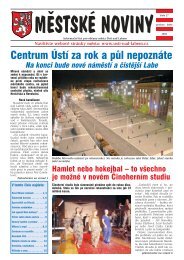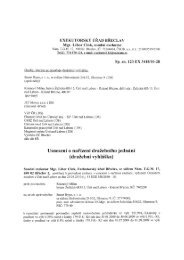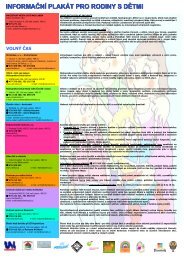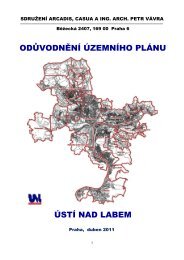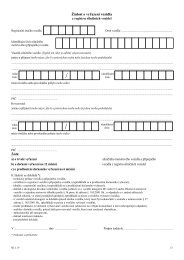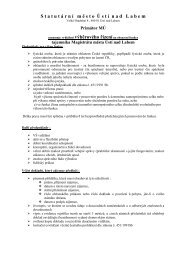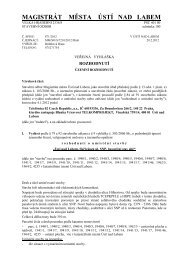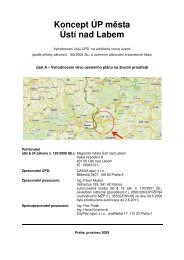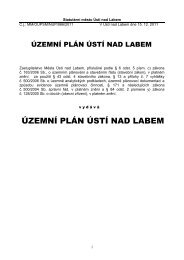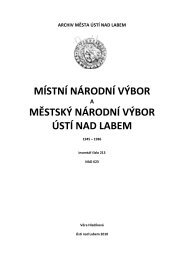Historie a památky města Ústí nad Labem History and monuments of ...
Historie a památky města Ústí nad Labem History and monuments of ...
Historie a památky města Ústí nad Labem History and monuments of ...
Erfolgreiche ePaper selbst erstellen
Machen Sie aus Ihren PDF Publikationen ein blätterbares Flipbook mit unserer einzigartigen Google optimierten e-Paper Software.
CZ ENG DE<br />
kancionály pro chrám sv. Víta, Žlutický a Čáslavský kancionál,<br />
graduál pro Týnský kostel, graduál a kancionál teplický atd. O<br />
Fabianovo dědictví se ucházela jeho sestra, která žila v <strong>Ústí</strong><br />
<strong>nad</strong> <strong>Labem</strong>.<br />
Ještě před polovinou 16. století se v <strong>Ústí</strong> <strong>nad</strong> <strong>Labem</strong> objevil<br />
další významný umělec, zlatník Florián Stosse, syn slavného<br />
norimberského sochaře Veita Stosse. Podle dobových zpráv<br />
opustil v roce 1543 slezský Frankenstein a odešel do <strong>Ústí</strong>. Zlatník<br />
Florián a jeho potomci jsou pak ve městě doloženi ve druhé<br />
polovině 16. století. Zájem umělců o <strong>Ústí</strong> pramenil v tomto<br />
období patrně z očekávaných zakázek, které souvisely s dokončováním<br />
interiéru kostela Nanebevzetí Panny Marie » a také z<br />
toho, že se město po neúspěšném stavovském odboji, kdy<br />
zůstalo věrné králi, dostalo do přízně panovnického dvora.<br />
V <strong>Ústí</strong> <strong>nad</strong> <strong>Labem</strong> se na přelomu 16. a 17. století, stejně jako v<br />
jiných městech, vytvořila společnost vzdělaných měšťanů, kteří<br />
21<br />
town, including its appearance <strong>and</strong> decoration <strong>of</strong> local churches.<br />
The history can be compared, for example, to the description<br />
<strong>of</strong> the town <strong>of</strong> Most from the pen <strong>of</strong> the general vicar<br />
<strong>of</strong> the Prague archiepiscopate <strong>of</strong> Jiří Berthold Pontano <strong>of</strong> Breitenberk,<br />
a native <strong>of</strong> Most.<br />
In the 16th century the national composition <strong>of</strong> the population in<br />
<strong>Ústí</strong> <strong>nad</strong> <strong>Labem</strong> changed. Although it is impossible to exactly<br />
specify the proportion <strong>of</strong> Czech <strong>and</strong> German inhabitants in the<br />
city, documents are provided by period papers documenting<br />
paperwork in <strong>Ústí</strong> <strong>nad</strong> <strong>Labem</strong>. The German language, which<br />
had never disappeared from the town paperwork, began to prevail<br />
in the papers <strong>of</strong> the city local government from the 1570´s<br />
<strong>and</strong> it completely dominated in the 1590´s. <strong>Ústí</strong> became a German<br />
speaking town at that time. This is indirectly documented<br />
in the poem about <strong>Ústí</strong> by J.A. Tichtenbaum, when he writes<br />
about the German clock located in the golden-plated tower <strong>of</strong><br />
the Brotherhood <strong>of</strong> Corpus Christi, built in 1613 in the middle <strong>of</strong><br />
the square. Unlike the Czech clock on the town hall, the German<br />
clock struck every half hour.<br />
The population <strong>of</strong> <strong>Ústí</strong> <strong>nad</strong> <strong>Labem</strong> was also divided in terms <strong>of</strong><br />
religion all through the 16th century. Catholicism, represented<br />
by the main Church <strong>of</strong> the Assumption <strong>of</strong> the Virgin Mary, had<br />
always had a strong position in the city thanks to an old tradition.<br />
The Utraquists were also represented in <strong>Ústí</strong> <strong>and</strong> gathered<br />
in the Church <strong>of</strong> St. Adalbert. As late as far beyond the mid<br />
16th century, the city was characterised by relatively great religious<br />
tolerance <strong>and</strong> perhaps also zero extremism in beliefs,<br />
which can be documented by the common bequest to both<br />
churches. Both main religious streams disliked the behaviour<br />
<strong>of</strong> the local nobility coming from Saxony which, influenced by<br />
the teachings <strong>of</strong> Martin Luther, enforced their peons to convert<br />
to the new religion. From the 1560´s , Lutherans spread among<br />
the town inhabitants as well, as we know from a complaint from<br />
the Catholic deans. The growing influence <strong>of</strong> the Lutheran religion<br />
also led in the end to the change in religion <strong>of</strong> some Catholic<br />
clergy. The case <strong>of</strong> the famous vicar Valentin Scherfer,<br />
documented in <strong>Ústí</strong> between 1573-74, who converted to the<br />
Lutheran religion <strong>and</strong> became a clergyman in Trmice, being an<br />
example. Lutheran priests were not allowed to preach directly<br />
in the town, the town Lutheran population usually visited churches<br />
near <strong>Ústí</strong> <strong>nad</strong> <strong>Labem</strong>, particularly in Svádov, Krásné Březno<br />
<strong>and</strong> Trmice. At the beginning <strong>of</strong> the 17th century, priest Jan<br />
Langenberger married in <strong>Ústí</strong>. He bought a house in the town,<br />
which he did not leave until after the Battle <strong>of</strong> White Mountain.<br />
At that time, the religious situation culminated <strong>and</strong> verged on<br />
a conflict in <strong>Ústí</strong> <strong>nad</strong> <strong>Labem</strong> as well as in the whole kingdom.<br />
sang, dessen Bedeutung und Wichtigkeit für die Stadtgemeinde<br />
das Beschaffen einer neuen Orgel für die Kirche Maria Himmelfahrt»<br />
im Jahre 1593, sowie auch eines wertvollen vierteiligen<br />
h<strong>and</strong>geschriebenen Gesangbuches für die literarische Bruderschaft<br />
belegt.<br />
RENAISSANCE ORGELSCHRANK<br />
Die Renaissance-Orgel in <strong>Ústí</strong> <strong>nad</strong> <strong>Labem</strong> ist nicht erhalten<br />
geblieben, allerdings ein Best<strong>and</strong>teil der Sammlungen des<br />
Museums der Stadt <strong>Ústí</strong> <strong>nad</strong> <strong>Labem</strong> » ist der wertvolle Rest des<br />
Renaissance-Orgelschrankes aus der Kirche des Hl. Florian in<br />
Krásné Březno (Schönpriesen) » aus dem Jahre 1606. Es h<strong>and</strong>elt<br />
sich um eine einzigartige Sehenswürdigkeit und es gibt<br />
nichts <strong>and</strong>eres Vergleichbares in Tschechien. Die erhaltengebliebenen<br />
Bilder aus dem 19. Jahrhundert zeigen, dass die<br />
ganze Orgel aus künstlerischer Hinsicht sehr interessant war –<br />
sie war mit Plastiken und Malereien geschmückt, welche eine<br />
Engelskapelle darstellten.<br />
Renaissance-Künstler in <strong>Ústí</strong> - Fabián Puléř und Florian<br />
Stosse<br />
Von den Bildnern, die im 16. Jahrhundert in der Stadt lebten,<br />
kann nur der Maler und Illuminator Fabián Puléř zuverlässig<br />
belegt werden. Er wurde um 1520 geboren und war wahrscheinlich<br />
mit dem Maler Stephan verw<strong>and</strong>t (Enkel). Es ist nicht klar,<br />
ob er irgendwo ausgebildet wurde, jedoch es wird vermutet,<br />
dass er auf die W<strong>and</strong>erschaft ging, bei welcher er einige bedeutende<br />
mitteleuropäische Werkstätten besuchte. Seit 1550 ließ<br />
er sich in Prag nieder, wo er im Jahre 1563 auch starb. Fabián<br />
wurde zu einem ausgesuchten Illuminator; aus seiner Werkstatt<br />
kommen eine Reihe bekannter Gesangbücher, z.B. zwei<br />
Gesangbücher für den St. Veitsdom, Žlutický und Čáslavský<br />
Gesangbücher, Gradual für die Týnský Kirche, Teplický Gradual<br />
und Gesangbuch u.a. Nach Fabians Erbschaft strebte sich<br />
seine Schwester, die in <strong>Ústí</strong> <strong>nad</strong> <strong>Labem</strong> lebte.<br />
Noch vor der Hälfte des 16. Jahrhunderts erschien ein weiterer<br />
bedeutender Künstler in <strong>Ústí</strong> <strong>nad</strong> <strong>Labem</strong>, und zwar der<br />
Goldschmied Florian Stosse, Sohn des berühmten Nürnberger<br />
Bildhauers Veit Stosse. Laut damaliger Berichte verließ der im<br />
Jahre 1543 das schlesische Frankenstein und ging nach <strong>Ústí</strong>.<br />
Der Goldschmied Florián und seine Nachkommen sind dann in<br />
der zweiten Hälfte des 16. Jahrhunderts in der Stadt belegt. Das<br />
Interesse der Künstler an <strong>Ústí</strong> stammte zu dieser Zeit wahrscheinlich<br />
aus den erwarteten Aufträgen, welche mit dem Fertigbau<br />
des Interieurs der Kirche Maria Himmelfahrt » zusammenhingen,<br />
und auch daraus, dass die Stadt nach dem erfolglosen<br />
Ständewiderst<strong>and</strong>, wo sie dem König treu ergeben war, in die<br />
Gunst des Herrschaftsh<strong>of</strong>es geriet.<br />
27



